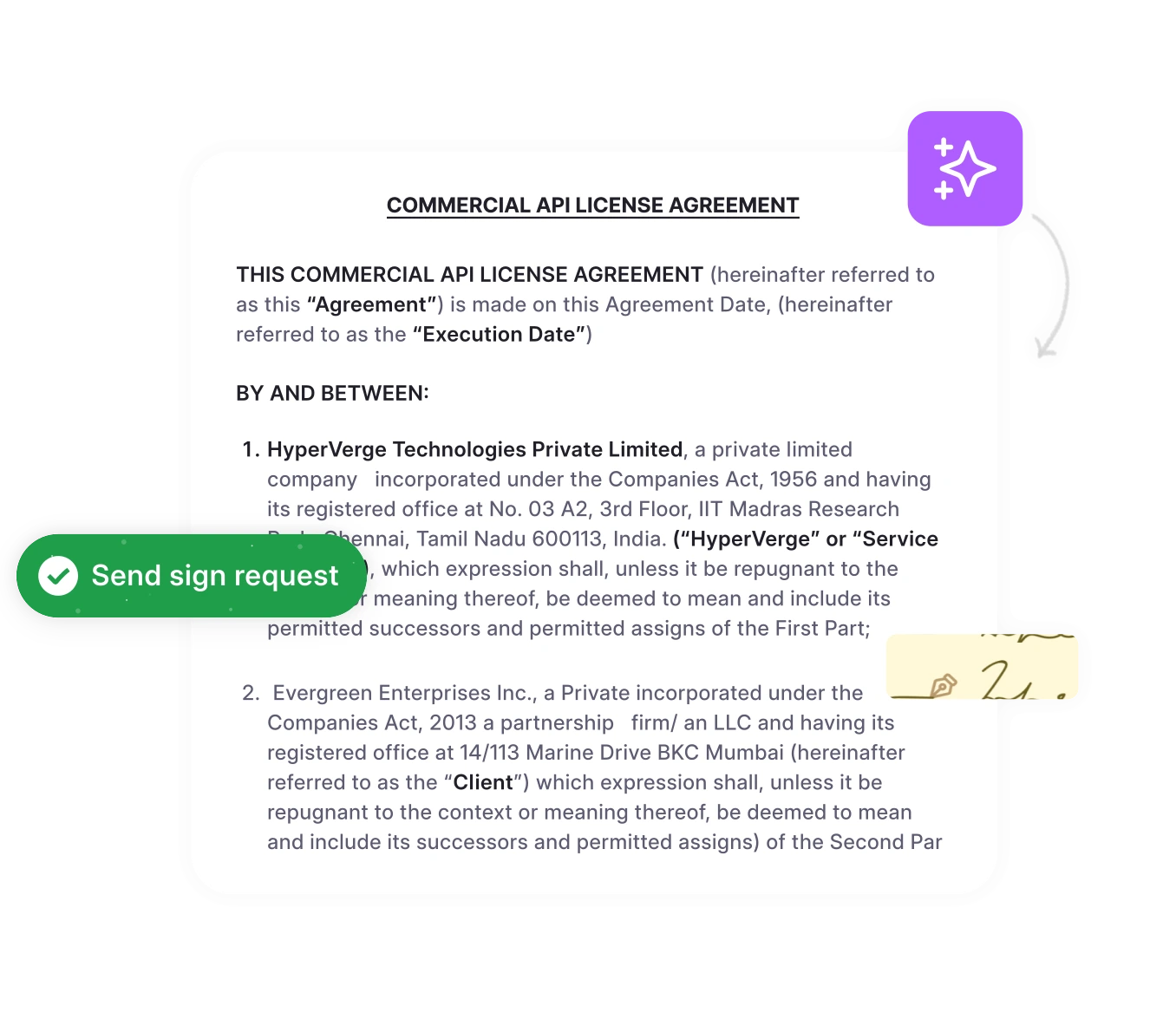What would you not give for a contract that’s simple with limited redlining? Deal delays because of manual markups can be frustrating, especially if business potential hangs in the balance.
Let’s suppose you’ve negotiated a fantastic partnership, but the back-and-forth redlining process drags on for weeks.
What’s the solution?
Contract management software is designed to simplify and speed up the entire redlining process, helping you avoid those dreaded delays.
In fact, according to a WorldCC report, the impact is substantial: 46.7% of organizations recognize the need for improvement in the redlining process and are considering contract management software, while 20.0% are already taking steps to implement a solution.
In this blog, we’ll cover the typical challenges legal teams face while contract redlining. Contrary to popular opinion, redlining is one job that cannot be fully automated. We’ll also learn how to transform your workflow with or without a contract management software for better collaboration and faster deal closures.
What is contract redlining?
Contract redlining is the process of editing and revising the contracts during the negotiation stage. This involves marking up the document with changes, comments, and suggestions, typically using track changes or a similar feature in a word processing tool.
Redlining helps all parties involved see the proposed modifications, facilitating transparent and efficient negotiation until the final terms are agreed upon and the contract is ready for execution.
The redlining process is a critical component of contract negotiation. It involves several key steps:
- Initial draft: A party creates the first draft of the contract and shares it with the other involved parties.
- Review and markup: Each party reviews the draft and makes changes, additions, or deletions. These modifications are typically highlighted or marked in red to differentiate them from the original text.
- Comment and suggestion: Parties add comments or suggestions to explain the reasoning behind their proposed changes. This fosters open communication and understanding between the parties.
- Negotiation and iteration: The redlined document is shared with negotiating parties. This stage often involves multiple rounds of revisions as parties work to reach a mutually agreeable contract.
- Final agreement: Once all parties agree on the changes, the redlined document is finalized, and the contract is ready for execution.
5 Challenges with manual redlining of contracts
Here’s how contract management software tackles the issues of manual redlining.
1. Unanticipated delays
Contract review and redlining the old-fashioned way involves passing physical documents or emailing attachments. It is slow and chaotic. Endless emails, Slack, and meetings drag out the process.
2. Scattered effort
Redlining legal documents traditionally involves documents often scattered across different devices, email inboxes, and physical files, making it hard to manage versions and track changes. Multiple versions make it hard to track latest changes made, when, and by whom.
3. Inaccuracy
Miscommunication, conflicting interpretations, and errors stem from overlooked notes, key details may be buried in emails or missing physical documents. They increase the risk of mistakes, compromising the contract accuracy and quality.
4. Inconsistency
When several stakeholders review a contract without benchmarks, it’s not difficult to muddle up contract language, font sizes, styles, formats, or spacing.
5. Confusion
Coordinating changes among multiple stakeholders can be tricky, especially with distributed teams. Without a centralized system, is the Tower of Babel all over again.
Fatigue sets in as the review process drags on as you try to nose out missing attachments, version history, at-risk clauses, facts, and inconsistencies.
AI Redline contracts in a few minutes
Redline smarter with HyperStart AI Assist for precedent language. Stop losing critical changes in emails and scattered versions. Without leaving MS Word
Book a DemoHow do you fix the problem (with or without a CLM)
Contracts are unlike any other writing forms. Writing formats like books, memos, and newspaper articles are structured so you read them from front to back in a sequence. But contracts are structured to collect related provisions that need to be cross-referenced to govern real-world commercial relationships.
So, identify fallback provisions, clauses, and positions that can be benchmarked according to both company standards and industry regulations. And make sure you enforce it across the board based on contract types, complexity, and risk.
1. Exchange with purpose
The objective of redlining should always be to drive the negotiation forward in your interest. Strive for minimal redlined exchanges. Ideally, one exchange from each side and one with the final nod.
- The initiating party offers a template.
- The counterparty provides input.
- Everyone finds common ground.
While most contract communications happen on email, negotiations happen live. Examples:
- Simple contracts: Short agreements(under 2 pages) like NDAs have limited negotiable terms and predictable variations. They need just one redline exchange via email.
- Complex contracts: Intricate contracts like MSAs and SaaS contracts may need 2+ exchanges and a working call to help align internal approvals before counterparty negotiation.
- Urgent contracts: When deadlines are critical, emails bottleneck progress. Start with a call to accelerate discussions.
2. Tell them why
Always leave comments against your redlines. ‘Rejected’ or ‘We cannot agree’ doesn’t advocate for you when you’re not in the room.
Instead, leave a summary on email or screen-share on a live call for redlines on deal-breaker clauses like:
- Exclusivity
- Indemnification
- Payments
- Liquidated damages
- SLAs, and so on.
Minor formatting changes and self-explanatory edits don’t need comments. “Heretofore” you may also avoid phrases “including but in no way limited to” this sentence, “notwithstanding anything to the contrary herein” “provided however” “for the avoidance of doubt” they hurt the deal. Does the contract need to run on synonyms; ALL-CAP, ITALICIZED, BOLDED, UNDERLINED SENTENCES; semicolons that further reinforce legal pedigree; and legalese only legal can understand?
Stay silent when you’ve already communicated your position. Let it sink deeply.
3. Get a CLM to automate it fully
Contracts need thorough documentation for compliance audits. Key decisions, final terms, version history and audit trails need to be logged centrally regardless of how negotiations unfold. So, it’s best to set up one searchable workspace like HyperStart.
What you can do:
- Design workflows: Sequentially configure contract approval workflow so only authorized users view and sign off clauses and relevant contracts. Automate alerts so you’re not manually routing them.
- Redline: Markup, comment, suggest, track changes, and collaborate real-time on in-browser MS Word editor
- Contract versions: Compare different versions and identify who made changes when to establish context quickly.
- Document everything: Watch communications and approvals at the workflow and clause levels with an audit-ready activity log.
A lot goes into redlining a contract properly. You can do with or without a CLM, depending on the contract volumes or levels of complexity you handle. So, assess your contract portfolio before you decide which practices you’d like to take away.
6 Smart approaches to contract redlining
Most contract review software today are competing for faster contract review times, AI accuracy, and automations that make your life simpler. Here are the 6 contract redlining best practices for faster, cleaner reviews:
1. Use a centralized platform
A centralized digital contract management system that consolidates all contract documents in one place. You can track changes in real time and ensure version control in a single source of truth. It minimizes the risk of lost or outdated documents and simplifies safe access for all stakeholders.
Benefits: Reduced confusion, easier tracking of edits, and streamlined contract management
2. Standardize workflow templates
Using pre-approved and standardized contract workflows ensures consistency across contract types and departments. You don’t have to manually follow up with stakeholders and the contract bee-lines to the right stakeholder at the right time.
Benefits: Ensures uniformity, compliance with organizational policies, and efficiency in contract creation
3. Implement clear tracking
Track, highlight, and log all changes, comments, and edits. You can backtrack for clarity and context any time.
Benefits: Enhances transparency, facilitates easy review of changes, and helps in understanding the evolution of the document.
4. Maintain consistent formatting
Iron out broken formatting to stay consistent throughout the document. Use uniform font sizes, styles, and spacing. This avoids visual discrepancies and ensures that the document looks professional.
Benefits: Improves readability, reduces the risk of errors, and maintains a polished appearance.
92% of respondents on a linkedin poll said they prefer Microsoft Word with track changes 8% said they preferred PDF redlines on Word
5. Review thoroughly
Conduct detailed reviews of redlined contracts, checking that each modification aligns with the contract’s objectives and legal requirements. This involves cross-checking changes with the original terms and conditions.
Benefits: Ensures adherence to objectives and reduces the likelihood of overlooked errors.
6. Automate where possible
Use automated redlining tools that leverage predefined rules and past agreements to suggest changes and standardize edits. Automation can help in quickly identifying deviations from standard terms.
Benefits: Speeds up the redlining process, reduces manual errors, and increases efficiency.
Who is involved in the contract redlining process, and why
A lawyer’s redlines show — in color! — how he or she envisions the relationship between the parties. It is the tangible expression of the negotiation process. By using the contract redline process in a thoughtful way, you can clarify your thinking, refine issues, and powerfully present ideas and interests in a compelling way.
A typical internal approval flow:
Business Requestor initiates → Contract Manager coordinates → Legal reviews → Finance approves → Department Head signs off → Executive Leadership authorizes (for contracts above threshold)
Let’s look at each of them in detail.
| Who | Why They’re Essential | What They Focus On |
| Legal Team | Risk & compliance | Reviewing legal enforceability and key clauses |
| Contract Manager | Process coordination | Managing timelines and stakeholder |
| Finance Team | Financial management | Budget impact, and financial risk assessment |
| Procurement | Vendor management | Negotiating favorable terms and tracking vendor performance |
| IT/Security Team | Technical requirements | Evaluating data protection, security, and technical standards |
| Department Head | Strategic resource allocation | Alignment objectives and resources |
Each stakeholder serves a specific purpose in protecting organizational interest. However, coordinating manually can become overwhelming—especially when you’re managing multiple contracts simultaneously.
This is exactly why many scaling organizations are turning to contract management software to streamline collaboration and accelerate the contract review process
Top 5 contract management software for contract redlining
Whenever you’re ready to move beyond clean Word and email chains, take a peek at the top 5 AI-powered redlining software that legal teams trust to accelerate contract negotiations.
| Software | Strengths | Unique Advantage |
| HyperStart CLM | 95% AI accuracy | AI Assist for fallback positions |
| Docusign CLM | Diverse integrations options | Gold-standard eSignatures |
| Agiloft | 99.6% successful implementations | Generative AI functionalities |
| PandaDoc | Pay per user | Intuitive interface |
| Concord | Unlimited documents, eSignatures, and free viewers | Clause library |
While each platform offers unique strengths, the key is to find the one that organically fits into your workflows and scales with your organization in the long run.
What makes HyperStart CLM the ideal redlining solution?
After evaluating 5+ contract managing platforms, LeadSquared chose HyperStart CLM for more reasons than one. HyperStart CLM has yielded significant benefits for them. We not only accelerated the contract review process, but streamlined the contract lifecycle end-to-end.
Read the full story here.
6+ hours
Saved with AI contract review
60%
Reduced contract creation time
92%
Faster contract reporting
Here are some of the key features of HyperStart CLM that help in contract redlining:
- AI-powered review: Automate up to 90% of redlining tasks with our AI-driven engine, which enhances efficiency and accuracy during contract negotiations.
- Version control: Keep track of all changes with robust version control, allowing you to manage versions of each document seamlessly.
- In-app editor: Make comments, suggest changes, and collaborate directly within HyperStart’s in-app editor. This integrated approach ensures all edits are consolidated in one place in real time.
- Microsoft Word plug-in: Prefer working in Word? Use our plug-in to access HyperStart’s powerful redlining features directly within your familiar Word environment. Enjoy seamless integration and enhanced productivity without switching platforms.
Want a practical look at how to accelerate contract redlining and close deals faster? Schedule a demo with HyperStart CLM to see how it transforms your process to redline contracts.
Frequently asked questions
- Centralized system of truth
- Clear naming conventions
- Automated version tracking
- Version comparison
- Comprehensive change logging
- Access controls and permissions
- Real-time collaboration



![A Guide to Contract Redlining [Challenges + Solutions + Top Software Tools]](https://www.hyperstart.com/wp-content/uploads/2024/07/Blog-82-purple-scaled.webp)








